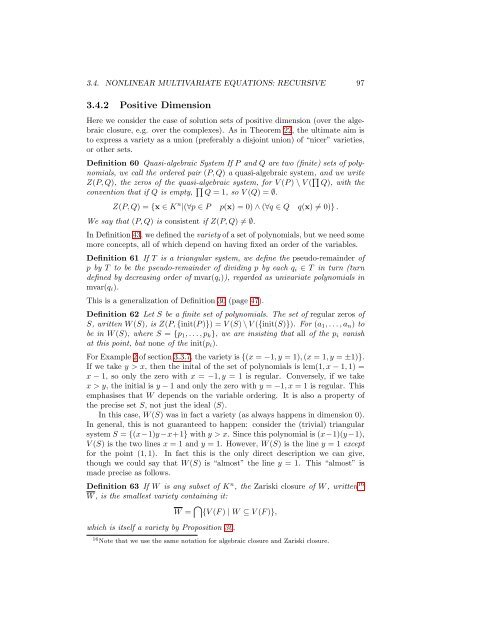Contents - Student subdomain for University of Bath
Contents - Student subdomain for University of Bath
Contents - Student subdomain for University of Bath
You also want an ePaper? Increase the reach of your titles
YUMPU automatically turns print PDFs into web optimized ePapers that Google loves.
3.4. NONLINEAR MULTIVARIATE EQUATIONS: RECURSIVE 97<br />
3.4.2 Positive Dimension<br />
Here we consider the case <strong>of</strong> solution sets <strong>of</strong> positive dimension (over the algebraic<br />
closure, e.g. over the complexes). As in Theorem 22, the ultimate aim is<br />
to express a variety as a union (preferably a disjoint union) <strong>of</strong> “nicer” varieties,<br />
or other sets.<br />
Definition 60 Quasi-algebraic System If P and Q are two (finite) sets <strong>of</strong> polynomials,<br />
we call the ordered pair (P, Q) a quasi-algebraic system, and we write<br />
Z(P, Q), the zeros <strong>of</strong> the quasi-algebraic system, <strong>for</strong> V (P ) \ V ( ∏ Q), with the<br />
convention that if Q is empty, ∏ Q = 1, so V (Q) = ∅.<br />
Z(P, Q) = {x ∈ K n |(∀p ∈ P p(x) = 0) ∧ (∀q ∈ Q q(x) ≠ 0)} .<br />
We say that (P, Q) is consistent if Z(P, Q) ≠ ∅.<br />
In Definition 43, we defined the variety <strong>of</strong> a set <strong>of</strong> polynomials, but we need some<br />
more concepts, all <strong>of</strong> which depend on having fixed an order <strong>of</strong> the variables.<br />
Definition 61 If T is a triangular system, we define the pseudo-remainder <strong>of</strong><br />
p by T to be the pseudo-remainder <strong>of</strong> dividing p by each q i ∈ T in turn (turn<br />
defined by decreasing order <strong>of</strong> mvar(q i )), regarded as univariate polynomials in<br />
mvar(q i ).<br />
This is a generalization <strong>of</strong> Definition 30 (page 47).<br />
Definition 62 Let S be a finite set <strong>of</strong> polynomials. The set <strong>of</strong> regular zeros <strong>of</strong><br />
S, written W (S), is Z(P, {init(P )}) = V (S) \ V ({init(S)}). For (a 1 , . . . , a n ) to<br />
be in W (S), where S = {p 1 , . . . , p k }, we are insisting that all <strong>of</strong> the p i vanish<br />
at this point, but none <strong>of</strong> the init(p i ).<br />
For Example 2 <strong>of</strong> section 3.3.7, the variety is {(x = −1, y = 1), (x = 1, y = ±1)}.<br />
If we take y > x, then the inital <strong>of</strong> the set <strong>of</strong> polynomials is lcm(1, x − 1, 1) =<br />
x − 1, so only the zero with x = −1, y = 1 is regular. Conversely, if we take<br />
x > y, the initial is y − 1 and only the zero with y = −1, x = 1 is regular. This<br />
emphasises that W depends on the variable ordering. It is also a property <strong>of</strong><br />
the precise set S, not just the ideal 〈S〉.<br />
In this case, W (S) was in fact a variety (as always happens in dimension 0).<br />
In general, this is not guaranteed to happen: consider the (trivial) triangular<br />
system S = {(x−1)y −x+1} with y > x. Since this polynomial is (x−1)(y −1),<br />
V (S) is the two lines x = 1 and y = 1. However, W (S) is the line y = 1 except<br />
<strong>for</strong> the point (1, 1). In fact this is the only direct description we can give,<br />
though we could say that W (S) is “almost” the line y = 1. This “almost” is<br />
made precise as follows.<br />
Definition 63 If W is any subset <strong>of</strong> K n , the Zariski closure <strong>of</strong> W , written 16<br />
W , is the smallest variety containing it:<br />
W = ⋂ {V (F ) | W ⊆ V (F )},<br />
which is itself a variety by Proposition 30.<br />
16 Note that we use the same notation <strong>for</strong> algebraic closure and Zariski closure.












![[Luyben] Process Mod.. - Student subdomain for University of Bath](https://img.yumpu.com/26471077/1/171x260/luyben-process-mod-student-subdomain-for-university-of-bath.jpg?quality=85)



